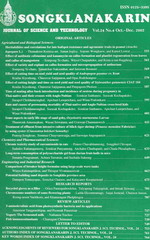ThaiScience
ThaiScience
SONGKLANAKARIN JOURNAL OF SCIENCE & TECHNOLOGY
Volume 42, No. 04, Month JULY, Year 2020, Pages 759 - 765
Laparoscopic vacuum testectomy technique for castration royal project bresse chickens on highland of thailand
Ongart Songsee , Suchon Tangtaweewipat , Boonlom Cheva-Isarakul and Tossapol Moonmanee
Abstract Download PDF
One hundred and eighty 4-week-old Bresse cockerels were allotted into 6 groups of 3 replications/group according to a 2x3 Factorial in a Completely randomized design. The main factor was traditional vs. custom or developed caponizing tools while the sub-factor was the age of the birds at castration i.e., 4, 6, and 8 weeks of age. All birds were raised on a highland farm in Thailand until 12 weeks old before slaughtering and carcass evaluation. Using the custom tools significantly decreased (P<0.05) incision size, caponizing time, mortality rate, and slip. At the same time the birds significantly increased average daily gain and feed intake but no significant differences on feed conversion ratio and carcass quality. Early age castration by the custom tools improved the efficiency and bird performance. In conclusion, the Laparoscopic vacuum testectomy technique can be done at 4 weeks of age. It minimized incision size, shortened caponizing time, and improved the performance of Bresse capon production at a highland farm of the Royal Project Foundation.
Keywords
Bresse, capon, castration, caponizing tool, laparoscopy vacuum testectomySONGKLANAKARIN JOURNAL OF SCIENCE & TECHNOLOGY
Published by : Prince of Songkla University
Contributions welcome at : http://rdo.psu.ac.th
